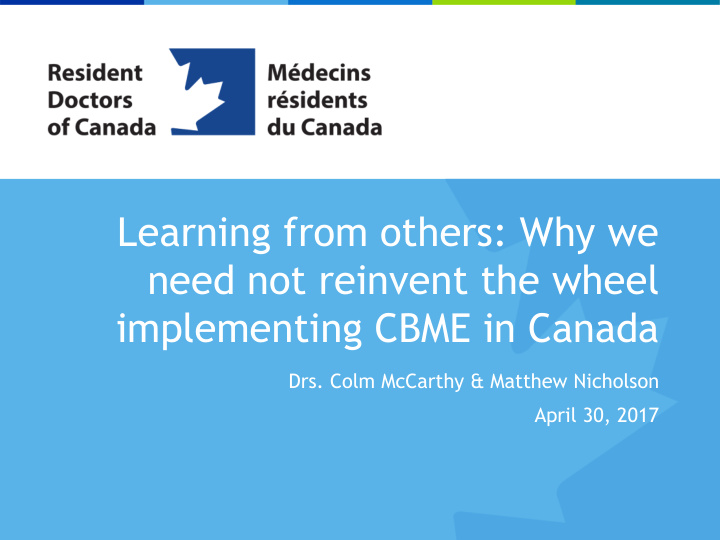



Learning from others: Why we need not reinvent the wheel implementing CBME in Canada Drs. Colm McCarthy & Matthew Nicholson April 30, 2017
Disclosure u We do not have any relevant financial relationships with commercial interests that pertain to the content of this presentation.
Why look outside of medicine? u Are medical competency u What are their shared traits? strategies particularly unique? u Competency based u High Risk u Shared means of assessment u Broad competencies and teaching
How to search the Grey literature u Grey literature consists of articles that are typically not found within peer-reviewed articles and journals. u Typically this search is labor intensive and requires strict vetting of articles. u Search engines typically must be broad engines, such as Google. u Google Scholar and Pubmed are typically too narrow.
How to find the signal in the noise u Focused search engine with relevant use of keywords. u Librarians are an excellent resource. u Abstract review u Full text review
What fields have CBD type training? u Agriculture u Nursing u Food Inspection u Education u Aviation
Resource 1: “Competency-Based Learning or Personalize Learning” u US Department of Education u Example New Hampshire HS u Extensive list of examples of u Follow the Child Campaign CBD implementation in u Individualized learning American learning tracks institutions on the state and district levels. u Students as active learners u Hyperlinked u Time Flexible u Summaries u Specific Course Level Competencies u Example New Hampshire HS u Clarification of u Specific Course Level competencies with grading Competencies rules u Clarification of competencies with grading rules
Resource 2: “Safe Food Canada: The Learning Partnership” u Government of Canada Website u Highly complicated curriculum u Very convoluted means of progression u Archived article u Chance of failure
Resource 3: “Design and Implementation of a Competency-Based Transfusion Medicine Training Program in Canada” u Transitioned from a Competency/Time model to a pure CB curriculum. u Review describes this process and the its application. u Trainees are generally self sufficient, educated, and motivated. u Assessment based on Miller’s Pyramid.
Resource 4: “Challenges in Developing Competency Based Training Curriculum for Food Safety Regulators in India” u Goals were to Identify u Curriculum Design: competencies, develop a CB u In-depth review of syllabus training curriculum, and and assessment. develop training materials u Review of international to train the workforce. materials with a dedicated u Five training modules were research team. developed. u Multiple workshops and group meetings to assemble u Major challenge is the final curriculum. implementation and resources for implementation.
Resource 4 (cont.)
Resource 5: “Veterans Affairs Interprofessional Nurse Practitioner Residency in Primary Care: A Competency-Based Program” u Tool: u Development of an assessment tool for NP’s to show effectiveness and u EPA based competence in essential interprofessional team based care: u Entrustment Likert u Ability to assess u Observer->Supervisor u Diagnosis u Qualitative Open Ended Questions u Treatment u Curriculum: u Management of common acute and chronic conditions u Workplace/Experiential u Patient centered care Didactic sessions u u Leadership u Self Evaluation and Mentor u Performance Improvement Evaluations u Population Health
How do these fields relate to medicine? u Transfer - near/far u Assessment Models u Continuing Education Models u Curriculum planning
So What? u Why do we care? u Why is this relevant? u What can we learn?
Workshop and Panel Discussion
Workshop and Panel Discussion u What do you think are two examples of “best practice” of competency-based education in your experience?
Workshop and Panel Discussion u What are two examples of “Worst Practice” of competency-based education in your experience? u Judgment Free Zone please!
Workshop and Panel Discussion u Moving forward, what fields outside of medicine do you feel are particularly rich for application towards CBME? u What are the untapped resources?
Workshop and Panel Discussion u Is CBD better for more advanced learners? u What does this mean?
Workshop and Panel Discussion u What can we learn from the grey literature about curriculum design when planning for CBME?
Workshop and Panel Discussion u What can we learn about assessment from outside fields when considering CBME?
References Larson, G. (1982). The far side . Andrews and McMeel. u Thippaiah, A., Allagh, K. P., & Murthy, G. V. (2014). Challenges in developing competency-based training curriculum for food u safety regulators in India. Indian journal of community medicine: official publication of Indian Association of Preventive & Social Medicine , 39 (3), 147. US Department of Education “Competency-Based Learning or Personalized Learning,” https://www.ed.gov/oii- u news/competency-based-learning-or-personalized-learning Government of Canada “Safe Food Canada: The Learning Partnership,” Government of Canada website, June 17-18, 2014 u http://www.inspection.gc.ca/about-the-cfia/transforming-the-cfia/action-plan/food-regulatory-forum/presentations/safe- food-canada/eng/1401631385284/1401631386315 Zeller, M. P., Sherbino, J., Whitman, L., Skeate, R., & Arnold, D. M. (2016). Design and Implementation of a Competency- u Based Transfusion Medicine Training Program in Canada. Transfusion medicine reviews , 30 (1), 30-36. Rugen, K. W., Speroff, E., Zapatka, S. A., & Brienza, R. (2016). Veterans Affairs Interprofessional Nurse Practitioner u Residency in Primary Care: A Competency-based Program. The Journal for Nurse Practitioners , 12 (6), e267-e273. Lobo, L. G., & Pérez, M. I. L. (2014). Certification of agricultural popular knowledge by using a competency-based training u curriculum for universities. Economía , 39 (37), 35-56. Lawson, R. A., Blocher, E. J., Brewer, P. C., Cokins, G., Sorensen, J. E., Stout, D. E., ... & Wouters, M. J. (2013). Focusing u accounting curricula on students' long-run careers: Recommendations for an integrated competency-based framework for accounting education. Issues in Accounting Education , 29 (2), 295-317. Ott, M., Baca, E., Cisneros, J., & Bates, E. (2015). A competency-based approach to the master's degree preparation of u higher education professionals. Journal of Case Studies in Accreditation and Assessment , 4 , 1.
Recommend
More recommend